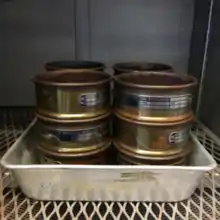Soil aggregate stability
Soil aggregate stability is a measure of the ability of soil aggregates to resist degradation when exposed to external forces such as water erosion and wind erosion, shrinking and swelling processes, and tillage (Papadopoulos, 2011;[1] USDA, 2008[2]). Soil aggregate stability is a measure of soil structure (Six et al., 2000a[3]) and can be impacted by soil management (Six et al., 1998[4]).

Overview
Why is aggregate stability important?
Aggregate stability is one of indicators of soil quality, as it combines soil physical, chemical, and biological properties (Doran & Parkin, 1996[5]). The formation of soil aggregates (or so-called secondary soil particles or peds) occurs due to interactions of primary soil particles (i.e., clay) through rearrangement, flocculation and cementation.
Aggregate stability has a direct impact on soil pore size distribution, which affects soil water retention and water movement in soil, therefore affecting air movement. A soil with good soil structure typically has a mix of micro-, meso-, and macropores. Therefore, with more aggregation, you would expect to have a higher total porosity compared to a poorly aggregated soil (Nimmo, 2004[6]). Micropores are important for water retention and storage in soils, while macro- and mesopores allow for the movement of water and air into the soil. A well aerated soil is important for plant and microbial health. Without access to oxygen, plant roots and aerobic microorganisms are unable to respire, and can die. To have a high biodiversity of soil organisms it is important to have a mix of different pore sizes and habitats in the soil (Trivedi, 2018[7]). Soil pores create space in the soil that allows for root penetrability. In a compacted soil with few aggregates and limited pore spaces, roots have difficulty growing and may be excluded from nutrients and water stored in different parts of the soil. Soils with good aggregate stability typically have a higher water infiltration rate, allowing more water into the soil profile faster, and are not susceptible to water ponding.
Factors affecting aggregate formation
Soil aggregates are formed due to flocculation and cementation processes, and are enhanced by physical and biological processes. Primary soil particles (sand, silt, and clay) are subjected to these processes, and can stick together to form larger sub-microaggregates (< 250 μm), microaggregates, and macroaggregates (> 250 μm). It has been suggested that soil aggregates form hierarchically, meaning larger less dense aggregates are composed of smaller more dense aggregates (Kay, 1990;[8] Oades, 1993[9]).
Flocculation
Flocculation refers to a state when primary soil particles (sand, silt, and clay) are drawn to each other by inter-particle forces to create microscopic floccules (or clumps). Inter-particle forces include: van der Waals forces, electrostatic forces, and hydrogen bonding. This is the opposite of dispersion, which occurs when individual primary soil particles are held apart. Soil particle dispersion and flocculation are mainly controlled by the soil pH,[10] electrical conductivity (EC), and sodium content.
Cementation
Microscopic floccules, will become aggregates once they are stabilized through cementation by one or several cementing agents such as carbonates, gypsum, sesquioxides, clay particles, and organic matter (Tisdall & Oades, 1982)[11]).
Carbonates and Gypsum
Calcium carbonate (CaCO3), magnesium carbonate (MgCO3), and gypsum (CaSO4.2H2O) can enhance soil aggregation when associated with clay minerals. The calcium ion (Ca2+), through its cationic bridging effect on flocculation of clay and organic matter compounds, has a crucial role in the formation and stability of soil aggregates. Calcium can exchange with sodium on exchange sites. This, in turn, reduces soil particle dispersion, surface crusting, and aggregate slaking associated with sodic soils and indirectly increase aggregate stability (Nadler et al., 1996[12]).
Sesquioxides
Tisdall and Oades (1982)[11] found that iron and aluminum hydrous oxides (or sesquioxides) can act as a cementing agents to form aggregates >100 μm, this effect becomes more pronounced in soil containing >10% sesquioxides. Sesquioxides act as stabilizing agents for aggregates because iron and aluminum in solution act as flocculants (i.e., bridging cations between negatively charged soil particles), and sesquioxides have potential to precipitate as gel on clay particles (Amézketa, 1999[13]).
Clay Particles
Soil clay particles have varying effects on aggregate formation, depending on its type. Soil with 2:1 type of phyllosilicate clay minerals (e.g., montmoriollinite) typically have high cation exchange capacity (CEC), which allows them to bind with polyvalently charged organic matter complexes to form microaggregates (Amézketa, 1999[13]). Soil organic matter is therefore the main binding agent in these soils (Six et al., 2000a[3]). On the other hand, in soils with oxides and 1:1 type of phyllosiliacte clay minerals (e.g., kaolinite), soil organic matter is not the only binding agent and aggregate formation is also due to electrostatic charges between and among oxides and kaolinite particles. Therefore, in these soils, aggregation is less pronounced (Six et al., 2000a[3]).
Soil Organic Matter
Soil organic matter can increase aggregate stability in soil, and can be classified based on how it is incorporated in soil aggregates in to:
- transient (polysaccharides fraction of soil organic matter),
- temporary (fungal hyphae and plant roots), and
- persistent (resistant aromatic compounds that are associated with polyvalent metal cations and strongly adsorbed polymers).
Temporary organic matter stabilizes macroaggregates (> 250 μm), while transient and persistent organic matter stabilizes microaggregates (Amézketa, 1999[13]). Soil or[8] ganic matter’s role in aggregate stability can be difficult to determine, due to several reasons:
- only part of the total soil organic matter plays a role in aggregate stability,
- there is a threshold of soil organic matter, above which aggregate stability cannot be improved by addition of organic matter, and
- organic matter is not the primary binding agent in that particular soil.
Wetting and Drying
Soil wetting and drying cycles can have both a beneficial effect on soil aggregation (Utomo and Dexter, 1982;[14] Dexter et al., 1988[15]), and a negative effect on soil aggregation (Soulides and Allison, 1961;[16] Tisdall et al., 1978[17]). To help explain these contradictory results, it was hypothesized that soils will maintain a state of aggregate stability equilibrium. If soils have certain properties, a threshold level will be reached where a period of wetting and drying will lead to increases or decreases in aggregate stability depending on the aggregate stability of the soil at that point in time.
Shrinking and Swelling
Shrinking and swelling cycles of soil are closely linked with wetting and drying cycles; however, they are also dependent on the type of clay phyllosilicate minerals present. Soils with higher content of 2:1 types of phyllosilicate minerals (such as montmoriolinite), have a stronger cementation force acting during repeated wetting and drying cycles, which can increase soil aggregate stability (Amézketa, 1999[13]). This is because 2:1 type phyllosilicate minerals swell and increase their volume with changing water content; meaning these soils expand when wet, and contract as they dry out. Through repeated shrinking and swelling action, soil aggregation occurs because of the rearrangement of soil particles due to the stress of increasing soil-water suction (Kay, 1990). Some soils even have the ability to “self-mulch”, meaning a desirable granular structure is formed at the surface of the soil due to the shrinking and swelling nature of the soil particles (Grant & Blackmore, 1991[18]).
Freezing and Thawing
When soils freeze and thaw, they undergo expansion and contraction. It was found that with higher water content in the soil at the time of freezing had a reducing effect on aggregate stability overall. The water expands in these soils and breaks apart the aggregates into smaller aggregates, while pores created by the freezing collapse once soils thaw (Amézketa, 1999[13]).
Soil Biological Factors
Soil biological processes are most important in soils that do not have 2:1 phyllosilicate clay minerals, and are therefore lacking in shrinking and swelling properties that can aid in structural formation (Oades, 1993[9]). Soil organisms can have an indirect and direct effects on soil structure at different levels of aggregate formation. Macrooaggregates (>2000 μm) are held together by plant roots and fungal hyphae, mesoaggregates (20-250 μm) are held together by a combination of cementing agents including: sesquioxides and persistent organic matter, and microaggregates (2-20 μm) are held together persistent organic bonds (Tisdall & Oades, 1982[11]). Soil fauna mix soil particles with organic matter to create close associations with one another.
Soil Fauna
Earthworms, termites, and ants are some of the most important invertebrates that are capable of having an effect on soil structure (Lee & Foster, 1991[19]). When earthworms ingest soil mineral and organic components, they can increase the structural stability of that soil through increased carbon-mineral associations and formation of casts, which increase aggregate stability (Tisdall & Oades, 1982;[11] Oades 1993[9]). Some earthworms are able to create stable microaggregates by flocculation of Ca2+ ions during digestion (Shiptalo & Protz, 1989[20]). Some microarthropods, including mites and collembola, although they are small, because there are large numbers of them, they are able to improve soil structure. These organisms are often associated with forest ecosystems, and can improve soil structure through the production of fecal pellets, from ingestion of a mixture of humic materials and plant debris (Lee & Foster, 1991[19]).
Fungi and Plant Roots
Tisdall and Oades (1982)[11] found that roots and fungal hyphae are important factors in aggregate formation. They are considered a temporary aggregate binding agent, and are typically associated with early stages of aggregate formation. Roots can act as a binding agent themselves, and can produce exudates that supply carbon to the rhizosphere organisms and soil fauna. Also, since roots uptake water, they can have a drying effect on the soil in their vicinity. Fungal hyphae can serve as binding agent that stabilizes macroaggregates and they also secrete polysaccharides that contribute to microaggregation.
Agricultural Management
How farmers manage their land can have profound changes in aggregate stability, which can either increase or decrease aggregate stability. The main disruptors of aggregate stability are: tillage, traffic from equipment, and traffic from livestock (Oades, 1993[9]). Tillage can disrupt soil aggregation in several ways: (i) it brings subsoil to the surface, thereby exposing it to precipitation and freeze-thaw cycles, and (ii) it changes soil moisture, temperature, and oxygen level, thereby increasing decomposition and carbon loss (Six et al., 2000a[3]). Using reduced tillage or zero tillage practices have been shown to improve soil aggregation compared to conventional tillage methods (Six et al., 2000b[21]). The use of cover crops has been shown to increase soil aggregation (Liu et al., 2005[22]), due to the increase of soil organic matter and soil cover that they provide. Perennial crops typically require a halt in tillage, which prevents aggregate disruption, and allows plant to develop an extensive root system which can promote aggregate stability. Additionally, inputs of organic matter in the form of mulch or manure application can increase aggregation by adding carbon to the soil matrix and increasing rates of biological activity in the soil (Amézketa, 1999[13]). Higher stocking rate of livestock such as cattle can decrease the aggregate stability of soil due to compaction of soil and loss of vegetation.
Soil Conditioners
Soil conditioners are amendments that can be applied to the soil to improve properties such as structure and water retention to improve soils for their intended use, but not specifically for soil fertility, although many soil amendments can alter the soil fertility. Some typical amendments include: lime, gypsum, sulfur, compost, wood wastes, peat, manure, biosolids, and biological amendments. In order to be effective, soil conditioners must be spread evenly across the field, be applied at the correct time to prevent nutrient loss, and have the correct nutrient content. Additionally, application of soil conditioners is site specific, and should be approached on a case by case basis, as a soil conditioner may not work on all soils equally (Hickman & Whitney, 1988[23]).
Climate
Variations in climate and seasons can have an effect on aggregate stability of the soil. According to Dimuyiannis (2008),[24] in a Mediterranean climate, it was found that aggregate stability varied on a nearly cyclical pattern, with lower aggregate stability in the winter and early spring compared to higher aggregate stability in the summer months. This variation in aggregate stability was found to be highly correlated with total monthly rainfall and average monthly rainfall. Aggregate stability can be impacted by the amount and intensity of precipitation. Higher amounts of precipitation and irregular rainfall events can decrease aggregate stability and increase erosion. Also, higher temperatures can increase the rates of decomposition in soil, which reduces the amount of carbon on the site, which can reduce aggregate stability. Many of the influences that climate has on soil aggregate stability are due to interactions of soil type with wetting/drying, shrinking/swelling, and freezing/thawing (Amézketa, 1999[13]).
How is aggregate stability measured?
Soil aggregate stability can be measured in several ways, since:
1. Soils aggregates can be destabilized by various external pressures brought about by wind, water, or machinery.
2. Soil aggregate stability can be determined at different size scales.
In most cases, the wet aggregate stability method is more relevant, because this method mimics the effects of water erosion, which is the driving force of erosion in most environments. However, in an arid environment, dry aggregate stability may be the more applicable method because it mimics wind erosion which is the driving force of erosion in these environments. Gilmour et al. (1948[25]) describes a method where aggregates are submersed in water, and the soil that is slaked off the aggregate is measured. Emerson (1964[26]) used a method whereby aggregates were subjected to different internal swelling pressures from different concentrations of sodium chloride (NaCl). Some common methodologies are described below.

Wet Aggregate Stability Method
A wet sieving apparatus described by Yoder (1936[27]) can be used to determine wet aggregate stability in the following procedure by Kember and Chepil (1965[28]), which was adapted by Nimmo and Perkins (2002[29]).
1. Sieve soil to obtain soil samples with aggregates between 2–4 mm size aggregates.
2. Weigh out 15 g of these 2–4 mm sized aggregates.
3. Place onto top of sieve nests with sieve size openings of 4.76 mm, 2.00 mm, 1.00 mm, and 0.21 mm.
4. Slowly wet the soils using a spray bottle and humidifier until aggregates become saturated and are glistening.
5. Place sieve nests into the wet sieving apparatus with 30 rotations/minute for approximately 10 minutes.
6. Remove the sieve nests and place in the oven at 105 °C for 24 hours.
7. Place approximately 7 g of wet soil into a weighed tin, then place in the oven at 105 °C for 24.
8. Weigh the dried soil each of the sieve nests



9. Samples can then be placed in a hexametaphosphate solution, to disperse the particles, then washed through the sieve again to remove sand particles. These sand particles can then be oven dried at 105 °C for 24 hours, weighted, and accounted for in the calculation for aggregate stability.
To calculate the mean weight, the following formulae can be used:
S4= Ws4.76/ (Ws/1+ø)
S2= Ws2/(Ws/1+ø)
S1= Ws1/(Ws/1+ø)
S0.21= Ws0.21/(Ws/1+ø)
S<0.21= 1- (S4.76+ S2+ S1+ S0.21)
Ø = (Wswet– Wsdry) / Wsdry
MWD (mm) = (S4.76*4.76)+(S2*2)+(S1*1)+(S0.21*0.21)+(S<0.21*0.105)
For formulas:
Ws4.76 = 4.76 mm sieve
Ws2 = 2 mm sieve
Ws1 = 1 mm sieve
Ws0.21 = 0.21 mm sieve
Wswet = weight of soil wet
Wsdry = weight of soil dry
Ø = water content
MWD (mm) = mean weight diameter
Dry Aggregate Stability Method
A dry sieving rotary cylinder described by Chepil (1962[30]) can be used in combination with a nested sieve design, as described by the following procedure by Metting and Rayburn (1983[31]):
1. Sieve soil samples to obtain aggregates from 0.92-1.68 mm in diameter.
2. Weigh out 2 kg of soil sample aggregates.
3. Arrange soil sieve nests with openings of >0.84, 0.84-0.42, and <0.42 mm.
4. Aggregates were then fed onto the sieve nests using a conveyor belt at a speed of 10 mm/s.
5. The rotary cylinder is then operated at 10 rotations per minute until the complete sample has been separated into aggregate fractions >0.84, 0.84-0.42, and <0.42 mm.

6. Dry stability is then measured as a percentage of aggregates that are >0.42 mm following rotary cylinder method.
Slaking Method
The slaking method used to measure soil aggregate stability is a measure of how well a soil aggregate sticks together when submersed in water. Several methods exist utilizing this method, one of which is the "Slakes: Soil Aggregate Stability" application developed by Fajardo and Britney (2019).[32] This method utilizes a smartphone and outlines how farmers and scientists are able to measure aggregate stability using samples from their field using the following method:
- Take a sample of soil from the field (at 0-7.5 cm) using a spade.
- Store the sample in the fridge until ready to analyze.
- Select samples using a ruler to obtain aggregates from 1–2 cm in diameter and place on a shallow dish with a plain white background that you can add water to.
- Set up your phone with a camera on the back so that it has a clear view of the soil aggregates.
- Add water to the dish to cover the aggregates and start the app.
- After several minutes, the aggregate will disperse to a varying degree.
- The app will then give you a score which can be used to determine how stable your aggregate and therefore soil is.
References
- Papadopoulos, A.; Bird, N. R. A.; Whitmore, A. P.; Mooney, S. J. (June 2009). "Investigating the effects of organic and conventional management on soil aggregate stability using X-ray computed tomography". European Journal of Soil Science. 60 (3): 360–368. doi:10.1111/j.1365-2389.2009.01126.x. ISSN 1351-0754.
- USDA Natural Resources Conservation Service (2008). "Soil Quality Indicators: Aggregate Stability" (PDF). nrcs.usda.gov.
- Six, J.; Elliott, E. T.; Paustian, K. (2000-05-01). "Soil Structure and Soil Organic Matter II. A Normalized Stability Index and the Effect of Mineralogy". Soil Science Society of America Journal. 64 (3): 1042–1049. doi:10.2136/sssaj2000.6431042x. ISSN 1435-0661.
- Six, Johan (1998). "Aggregation and Soil Organic Matter Accumulation in Cultivated and Native Grassland Soils". Soil Science Society of America Journal. 62 (5): 1042–1049. Bibcode:1998SSASJ..62.1367S. doi:10.2136/sssaj1998.03615995006200050032x.
- Doran, John W.; Jones, Alice J.; Doran, John W.; Parkin, Timothy B. (1996). "Quantitative Indicators of Soil Quality: A Minimum Data Set". Methods for Assessing Soil Quality. SSSA Special Publication. doi:10.2136/sssaspecpub49.c2. ISBN 978-0-89118-944-2.
- Nimmo, J.R., 2004, Porosity and Pore Size Distribution, in Hillel, D., ed. Encyclopedia of Soils in the Environment: London, Elsevier, v. 3, p. 295-303.
- Trivedi, Pankaj; Singh, Bhupinder P.; Singh, Brajesh K. (2018-01-01), Singh, Brajesh K. (ed.), "Chapter 1 - Soil Carbon: Introduction, Importance, Status, Threat, and Mitigation", Soil Carbon Storage, Academic Press, pp. 1–28, doi:10.1016/b978-0-12-812766-7.00001-9, ISBN 978-0-12-812766-7, retrieved 2020-03-10
- Kay, B. D. (1990). "Rates of Change of Soil Structure Under Different Cropping Systems". Advances in Soil Science 12. Advances in Soil Science. 12. pp. 1–52. doi:10.1007/978-1-4612-3316-9_1. ISBN 978-1-4612-7964-8.
- Oades, J.M. (March 1993). "The role of biology in the formation, stabilization and degradation of soil structure". Geoderma. 56 (1–4): 377–400. Bibcode:1993Geode..56..377O. doi:10.1016/0016-7061(93)90123-3. ISSN 0016-7061.
- http://soilweb200.landfood.ubc.ca/interactions-among-soil-components/4-soil-acidity/
- TISDALL, J. M.; OADES, J. M. (June 1982). "Organic matter and water-stable aggregates in soils". Journal of Soil Science. 33 (2): 141–163. doi:10.1111/j.1365-2389.1982.tb01755.x. ISSN 0022-4588.
- Nadler, A.; Levy, G. J.; Keren, R.; Eisenberg, H. (1996). "Sodic Calcareous Soil Reclamation as Affected by Water Chemical Composition and Flow Rate". Soil Science Society of America Journal. 60 (1): 252. Bibcode:1996SSASJ..60..252N. doi:10.2136/sssaj1996.03615995006000010038x.
- Amézketa, E. (1999). "Soil Aggregate Stability: A Review". Journal of Sustainable Agriculture. 14 (2–3): 83–151. doi:10.1300/J064v14n02_08.
- UTOMO, W. H.; DEXTER, A. R. (December 1982). "Changes in soil aggregate water stability induced by wetting and drying cycles in non-saturated soil". Journal of Soil Science. 33 (4): 623–637. doi:10.1111/j.1365-2389.1982.tb01794.x. ISSN 0022-4588.
- DEXTER, A. R.; HORN, R.; KEMPER, W. D. (June 1988). "Two mechanisms for age-hardening of soil". Journal of Soil Science. 39 (2): 163–175. doi:10.1111/j.1365-2389.1988.tb01203.x. ISSN 0022-4588.
- Soulides, D. A.; Allison, F. E. (May 1961). "Effect of Drying and Freezing Soils on Carbon Dioxide Production, Available Mineral Nutrients, Aggregation, and Bacterial Population". Soil Science. 91 (5): 291–298. Bibcode:1961SoilS..91..291S. doi:10.1097/00010694-196105000-00001. ISSN 0038-075X.
- Tisdall, JM; Cockroft, B.; Uren, NC (1978). "The stability of soil aggregates as affected by organic materials, microbial activity and physical disruption". Soil Research. 16: 9. doi:10.1071/sr9780009.
- Grant, CD; Blackmore, AV (1991). "Self mulching behavior in clay soils - its definition and measurement". Soil Research. 29 (2): 155. doi:10.1071/sr9910155.
- Lee, KE; Foster, RC (1991). "Soil fauna and soil structure". Soil Research. 29 (6): 745. doi:10.1071/sr9910745.
- Shipitalo, M.J.; Protz, R. (1989). "Chemistry and micromorphology of aggregation in earthworm casts". Geoderma. 45 (3–4): 357–374. Bibcode:1989Geode..45..357S. doi:10.1016/0016-7061(89)90016-5.
- Six, J.; Elliott, E.T; Paustian, K. (2000). "Soil macroaggregate turnover and microaggregate formation: A mechanism for C sequestration under no-tillage agriculture". Soil Biology and Biochemistry. 32 (14): 2099–2103. CiteSeerX 10.1.1.550.9255. doi:10.1016/s0038-0717(00)00179-6.
- Liu, Aiguo; Ma, B. L.; Bomke, A. A. (2005-11-01). "Effects of Cover Crops on Soil Aggregate Stability, Total Organic Carbon, and Polysaccharides". Soil Science Society of America Journal. 69 (6): 2041–2048. Bibcode:2005SSASJ..69.2041L. doi:10.2136/sssaj2005.0032. ISSN 1435-0661.
- Hickman, J. S. and D. A. Whitney. 1988. Soil conditioners. North Central Regional Extension Publication 295. 4 pp.
- Dimoyiannis, D. (May 2009). "Seasonal soil aggregate stability variation in relation to rainfall and temperature under Mediterranean conditions". Earth Surface Processes and Landforms. 34 (6): 860–866. Bibcode:2009ESPL...34..860D. doi:10.1002/esp.1785. ISSN 0197-9337.
- Gilmour, C. M.; Allen, O. N.; Truog, E. (1949). "Soil Aggregation as Influenced by the Growth of Mold Species, Kind of Soil, and Organic Matter". Soil Science Society of America Journal. 13: 292–296. Bibcode:1949SSASJ..13..292G. doi:10.2136/sssaj1949.036159950013000c0053x.
- Emerson, WW (1964). "The slaking of soil crumbs as influenced by clay mineral composition". Soil Research. 2 (2): 211. doi:10.1071/sr9640211.
- Yoder, Robert E. (1936). "A Direct Method of Aggregate Analysis of Soils and a Study of the Physical Nature of Erosion Losses". Agronomy Journal. 28 (5): 337. doi:10.2134/agronj1936.00021962002800050001x.
- Black, C.A.; Kemper, W. D.; Chepil, W. S. (1965). "Size Distribution of Aggregates". Methods of Soil Analysis. Part 1. Physical and Mineralogical Properties, Including Statistics of Measurement and Sampling. Agronomy Monograph. doi:10.2134/agronmonogr9.1.c39. ISBN 978-0-89118-202-3.
- Dane, Jacob H.; Topp, Clarke G.; Nimmo, John R.; Perkins, Kim S. (2002). "2.6 Aggregate Stability and Size Distribution". Methods of Soil Analysis: Part 4 Physical Methods. SSSA Book Series. doi:10.2136/sssabookser5.4.c14. ISBN 978-0-89118-893-3.
- Chepil, W.S. (1962). "A compact rotary sieve and the importance of dry sieving in physical soil analysis" (PDF). Soil Science Society of America Proceedings. 26 (1): 4–6. Bibcode:1962SSASJ..26....4C. doi:10.2136/sssaj1962.03615995002600010002x.
- Metting, Blaine; Rayburn, William R. (1983). "The Influence of a Microalgal Conditioner on Selected Washington Soils: An Empirical Study". Soil Science Society of America Journal. 47 (4): 682. Bibcode:1983SSASJ..47..682M. doi:10.2136/sssaj1983.03615995004700040015x.
- Fajardo, M. McBratney, A. (2019). Slakes: A soil aggregate stability smart-phone app [Mobile application software]. Retrieved from https://play.google.com/store/apps/details?id=slaker.sydneyuni.au.com.slaker&hl=en. The University of Sydney, Australia.